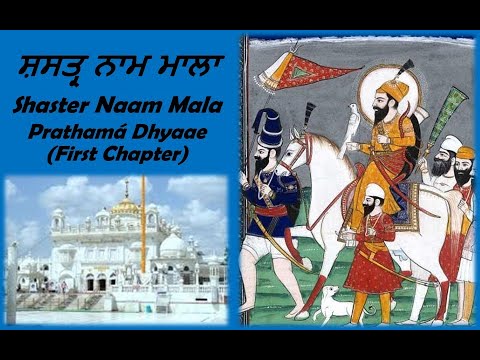This video was uploaded on Oct 6, 2021
This is the recitation of Shaster Naam Mala Puraan (Prathamá Dhyaae – First Chapter) from the Dasam Granth Sahib at Takht Suckhand Sri Abachal Nagar Hazur Sahib by the late Giani Vijender Singh Kapoor, the former head Kathavachak of Takht Sri Hazoor Sahib during the Dussehra Mahatam Paath in 2020 (during Navratri). (More Info on this tradition can be found by watching this video – https://youtu.be/BiXun-yYy14 ). In the early 1900s, Baba Mitt Singh Ji appointed Baba Sahib Singh Ji Kaladhari as the head of the Budha Dal (Group of elders within the Nihang order), on the condition that he returns to Punjab and revives the tradition of Shaster Puja and Dussehra, which was on the verge of extinction in Punjab during the colonial era. I’ve added some English translations to the recitation of Shaster Naam Mala (First Chapter) based on previously existing exegesis, interpretations within steeks, and custom translations with the help of some dictionaries. This specific bani, like a vast majority of the others within the Dasam Granth Sahib, was completed before 1698 AD, and before the Khalsa Panth was established. In the years 1695/1696 AD, members of Guru Gobind Singh Ji’s entourage began the task of putting together and rearranging the banis composed by him into a single granth (book), titled “Bani Shri Mukhwak Patshahi 10” in what is today known as the Anandpuri Bir of Dasam Granth Sahib. This task was performed at/near Anandpur Sahib, where Guru Sahib was residing at that time. Bhai Hardas Ji (the grandfather of S. Jassa Singh Ramgarhia) was one of the four main scribes who carried out this specific task. In 1698, further copies of the Dasam Granth Sahib were started once the Raam Avtar composition was completed by Guru Gobind Singh Ji and added into the Chobis Avtar section of the Dasam Granth. After that, later works composed by Guru Gobind Singh Ji (such as the Zafarnama) continued to be added into the manuscripts. That practice continued until 1708 CE, the year in which Guru Gobind Singh Ji left the mortal world. Bhai Saroop Singh Kaushish, who recorded Sikh history on the basis of the Bhatt Vahis in 1790 AD, mentions how Guru Gobind Singh Ji recited the specific shabad “As Kirpan Khando Kharag” (Starting from verse 3 of Shaster Naam Mala’s First Chapter) after he prepared the Amrit for the first Punj Pyare on Vaisakhi of 1698/1699 AD. This detail is written in a book called Guru Kian Sakhian (1790 AD) and refers to other compositions of Guru Gobind Singh Ji as well.
Copying and publishing of the information (including but not limited to: translations, analysis, and write ups) shared on PuratanM.com and Traditional Dharmic Truth Seeker without permission, without proper citation, and/or without adequate credit is a violation of copyright and an infringement of intellectual property.
